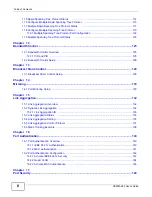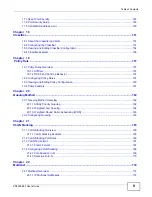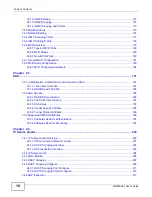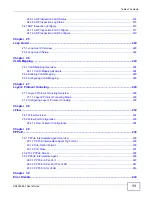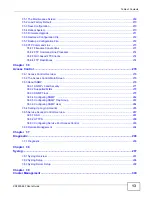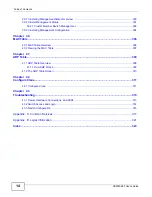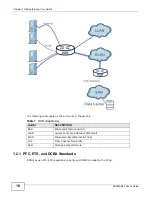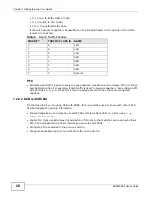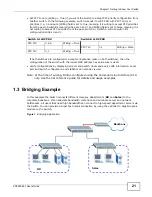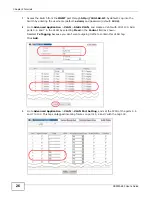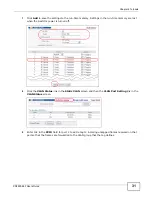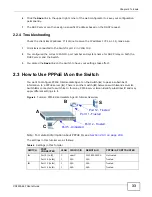
Chapter 1 Getting to Know Your Switch
XS3900-48F User’s Guide
19
• PFC (Priority-based Flow Control, IEEE 802.1Qbb -2011) is a flow control mechanism that uses a
PAUSE frame to suspend traffic of a certain priority rather than drop it when there is network
congestion (lossless). If an outgoing (egress) port buffer is almost full, the Switch transmits a
PAUSE frame to the sender who just transmitted traffic requesting it to stop sending traffic of a
certain priority to that port. For example, say outgoing port 8 is receiving too much traffic of
priorities 3-6 from port 1. Then if port 1 is configured with PFC priorities 3-6, port 1 can request
the sender to suspend traffic with priorities 3-6.
Similarly, if the outcoming (egress) port 8 receives a PAUSE frame with PFC priorities 0-1, then if
port 8 is configured with PFC, it can suspend sending traffic with PFC priorities 0-1.
• ETS (Enhanced Transmission Selection, IEEE 802.1Qaz -2011) is used to allocate bandwidth for
different traffic classes, based on IEEE802.1p priority (0 to 7, allowing for eight types of traffic)
with a guaranteed minimum bandwidth.
• Application priority is used to globally assign a priority to all FCoE traffic on the Switch.
• DCBX (Data Center Bridging capability eXchange, IEEE 802.1Qaz -2011) uses LLDP (Link Layer
Discovery Protocol) to advertize PFC, ETS and application priority information between switches.
PFC information should be consistent between connected switches, so PFC can be configured
automatically using DCBX.
1.2.2 DCB Configuration
You should configure DCB on any port that has both Ethernet and FCoE traffic.
1.2.2.1 DCB Only
Do the following if you’re just using DCB, that is, switches don’t need to know DCB-related
configurations via DCBX.
ETS
• Configure ETS to define traffic classes based on priority. Assign a weighted guaranteed
bandwidth for non strict priority (SP) traffic. SP traffic always has first priority.
First, define traffic classes. This is an example where the non-editable default traffic class, ID 0,
uses SP queuing. LAN and SAN traffic uses WFQ queuing with equal weighting of 50 each.
Next, define relative weights for non-SP traffic. In the example, the guaranteed minimum
bandwidth for both SAN and LAN traffic is 2.5Gbp with a physical link bandwidth of 10Gbps.
Next, configure port 1 and bind priorities as follows:
Table 2
Defined Traffic Classes
TRAFFIC CLASS ID
GUARANTEED BANDWIDTH
CLASS NAME
0
SP
Default
1
50
SAN
2
50
LAN
Table 3
Defined Relative Weights
NAME
INCOMING TRAFFIC
BANDWIDTH (GBPS)
GUARANTEED MINIMUM
BANDWIDTH
OUTGOING TRAFFIC
BANDWIDTH (GBPS)
Default
5
5 (SP)
5
SAN
3
(10-5) * (50/(50+50)) = 2.5
2.5
LAN
4
(10-5) * (50/(50+50)) = 2.5
2.5
Содержание XS-3900-48F
Страница 15: ...15 PART I User s Guide ...
Страница 16: ...16 ...
Страница 48: ...Chapter 2 Tutorials XS3900 48F User s Guide 48 ...
Страница 62: ...Chapter 4 The Web Configurator XS3900 48F User s Guide 62 ...
Страница 63: ...63 PART II Technical Reference ...
Страница 64: ...64 ...
Страница 227: ...Chapter 26 VLAN Mapping XS3900 48F User s Guide 227 ...
Страница 320: ...Appendix A Common Services XS3900 48F User s Guide 320 ...
Страница 332: ...Index XS3900 48F User s Guide 332 ...




